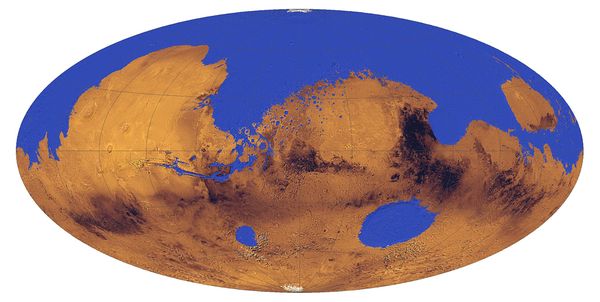July 22, 2014 – Without the ocean Earth would be a pretty inhospitable place even though we lie within our Sun’s Goldilocks Zone. Those of you who live by the ocean can probably figure out why that is the case. You see the ocean is a temperature moderator and a heat transport mechanism that evens out the climate across the planet. Yes we still have extreme cold in polar regions, and extreme heat near the equator, but for much of the world the temperatures are temperate because we have an ocean.
Researchers at the University of East Anglia recently published the results of a study entitled, The Importance of Planetary Rotation Period for Ocean Heat Transport. In it they state that habitability “depends on how its [referring to a planet] atmospheric and ocean circulation transports heat from warmer to cooler regions.”
For example, if Mars today had an ocean it wouldn’t experience the dramatic diurnal temperature swings in the atmosphere of the planet. The reality of Mars’ climate is well documented by the Curiosity rover. When it first landed at the Gale Crater on Mars it was approaching winter. At the time the rover recorded daytime highs of 6 Celsius (43 Fahrenheit) with lows of minus 70 Celsius (minus 94 Fahrenheit) overnight. Since then scientists have seen Gale Crater temperatures reach the mid-teens Celsius at midday while plunging as much as 100 Celsius (180 Fahrenheit) degrees throughout the Martian night.
What would researchers expect Mars to be like in altered circumstances based on where it lies at the outer edge of our Solar System’s Goldilocks Zone? A number of factors contribute to heat distribution across a planet. First of course is the amount of solar radiation striking its surface. Second is the composition of the atmosphere and it heat absorption capacity. Third is the rate of rotation. Fourth is the orbital plane (Earth’s tilt of 23 degrees creates our seasons). And fifth is the presence of significant bodies of liquid water on its surface.
In the research paper it notes that rotation periods from 1 to 16 Earth days alter heat distribution poleward by as much as 30 Celsius (54 Fahrenheit) degrees. A lower rate of rotation than 1 Earth day has the reverse effect limiting the heat transport mechanism across the planet. So here on Earth we benefit from both a planet that rotates and is covered more than 70% by water. The latter, the water, is as critical to the planet’s habitability.
The combination of the two produces interesting dynamics as well. According to the models as you change rotation periods you alter heat distribution throughout the ocean water column, not just at the surface. Increase rotation periods and poleward heat transport increases as well.
We know that early Earth had a much shorter day than the 24 hours we experience today. Scientists believe a day lasted a mere 12 hours back then. Based on the modeling in this study, early Earth’s oceans, therefore, must have been warmer than those of today.
Now relate that to Mars where we know from our many robotic spacecraft and landers that the planet in its early geological history was extensively water covered (see image below). If, like Earth, its rotation was faster back then, it is likely that Martian oceans presented a suitable environment to support life as we know it.
The modeling done by this study should prove helpful when examining exoplanet discoveries. Those exoplanets which we have observed to be tidally locked (rotation matches one orbit around its parent star) should be ruled out as likely candidates for evidence of life. But for many others with rotational ranges from 1 to 10 Earth days, lying within Goldilocks Zones, and with evidence of oceans, these may be the places where we should look to find if we are not alone.
The study appears in the journal Astrobiology.













